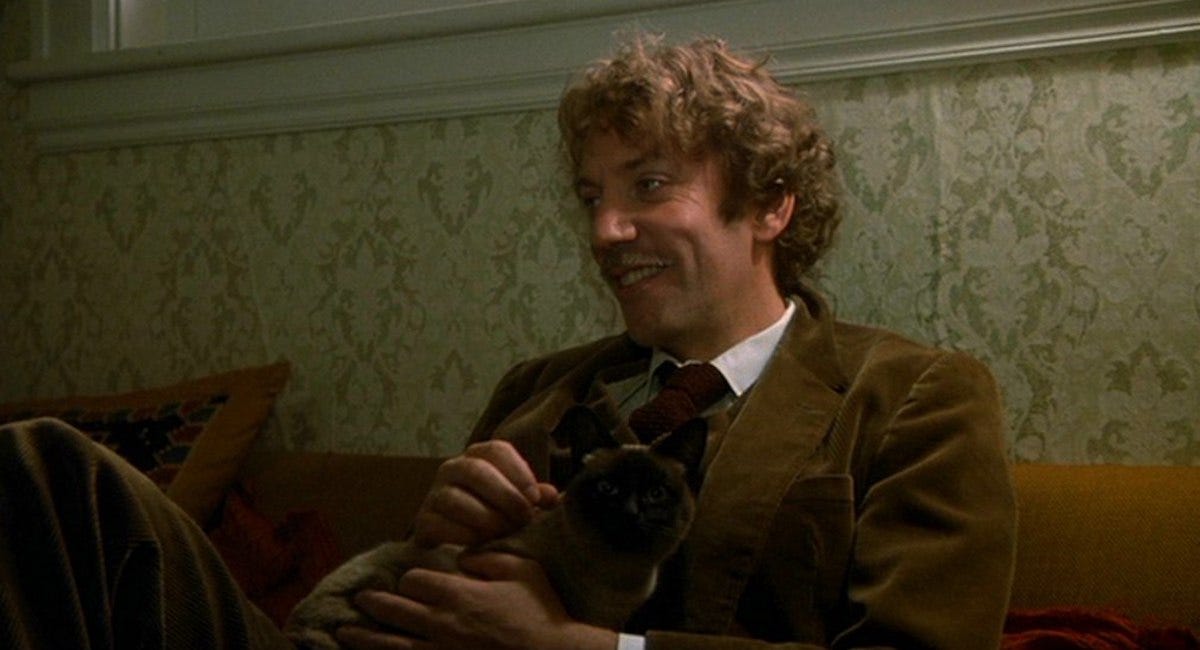RIP Donald Sutherland (1935-2024)
Donald Sutherland’s greatness rested in his versatility, and the key to his versatility was this slight smile he could do: there was an impishness, a puckishness to him. He was always in on the joke.
Obviously, this served him well in Animal House, where he played a bored professor who gets a little too close to his students, and M*A*S*H, Robert Altman’s raucous take on Vietnam through the lens of the Korean War. But it was a key part of his charm elsewhere, be it as the villainous Snow from the Hunger Games movies or as a man watching the world go mad in 1978’s underappreciated Invasion of the Body Snatchers remake.
My favorite performance by Sutherland is a short one, just one scene. It comes about midway through Oliver Stone’s JFK; in it, he plays X, a former military man who was privy to governmental weirdness leading up to the assassination of the president and who serves as the lead source for Jim Garrison (Kevin Costner), the crusading (and, I think it’s fair to say, deluded) district attorney who charged a gay New Orleans anticommunist with conspiracy to commit JFK’s murder.
Sutherland does something in that role I’ve never quite seen before or since in a movie, which is that he perfectly apes the rhythms and the moods of the conspiracy theorist: in a soothing, sonorous tone he piles facts on top of each other, remorselessly, relentlessly. He overwhelms with information and assumes you’ll connect the threads as he’s connected them. If you’ve ever spent any time around people of this sort, you recognize the M.O. instantly: the successful loons are calm rather than manic, and they tell their stories with an amused smile rather than an angry grimace. They’re revealing a secret to you, you see, they’re giving you the key. And the key unlocks something almost funny. You can’t help but smile when it’s all revealed.
One is tempted to dismiss the sequence as an exposition dump, even though that’s what most conspiracy theories are: exposition dumps. But Sutherland (with, let’s be fair, a big assist from writer-director Stone, editors Joe Hutshing and Pietro Scalia, and master composer John Williams) makes it so much more; he gives it Shakespearean heft. And he does it all while barely holding back a half-grin, a sort of “can you believe the audacity of it all?” look.
One needn’t buy JFK as good history (lord knows I don’t) to recognize that this is an absolutely perfect performance, one that nails not just the character but summarizes the whole vibe of the film. RIP, Mr. Sutherland. You will be missed.
You Are What You Wear
I’m kind of fascinated by Netflix’s announcement that the streaming company plan on opening two massive retail/experiential spaces in Pennsylvania’s King of Prussia Mall and Dallas, Texas’s Galleria. A combination of retail, restaurants, and immersive activities, the Netflix Houses will be designed to appeal to the folks who love Squid Game, Bridgerton, and Stranger Things.
Netflix wants to nurture fandoms and create community, helping their customers identify more deeply with the characters they see on their screens. This is an entirely understandable goal: when audiences make their entertainment part of their identity, the entertainment has a longer life. This is why Disney has nurtured the so-called Disney Adults who spend all of their disposable income on Disney vacations.
It called to mind a chapter from Walt Hickey’s book, You Are What You Watch, in which Hickey discussed the rise of Warner Bros. stores and the way Warner Bros. discerned early on that different types of customers were interested in different Looney Tunes characters and that you could sell different merch to them based on their cartoon character type.
Linda Postell, who set up the stores for Warner Bros., helped found this strategy. “What I realized very, very early on was that when you talk to the people who grew up in the ’60s and ’70s, this group of people totally identify with one, maybe two characters, period,” she told Hickey. “If they’re a tough guy, and they have a Harley-Davidson, they’re a Taz guy. If they’re sarcastic and glip, they’re a Daffy Duck guy. … There’s a group of people that love Foghorn Leghorn—and they all look the same. It’s mind-boggling.”
Perhaps even more interesting, as Hickey notes, is that the company would then mold products to that character’s (and thus, the customer’s) sensibility. “You wouldn’t make a biker jacket of Tweety, nor would you design a gardening set featuring a Tasmanian agent of destruction. But the Harley-Davidson jacket with Taz on it sold out in a week. A gardening set for the Tweety gang was a bestseller from Macau, China, to London England,” Hickey writes.
This was all part of a broader movement in leaning into adult audiences for fandom, which made some sense: Adults, after all, are the ones with the disposable income, and a combination of cultural stagnation and sustained cultural adolescence1 meant that the folks who grew up watching, say, Adam West’s Batman and reading Batman comic books were willing to drop $20 on a set of pins when Tim Burton’s Batman dropped in 1989.
Which brings me back to the Netflix Houses. Disney Stores and Warner Bros. stores make a certain amount of sense: these are brands with decades-old icons, characters who have stayed the same age while the kids who loved them have gotten older and had kids of their own. But Netflix is, almost by its nature, a relatively ephemeral phenomenon. The idea of someone modeling their clothing choices on a character from Stranger Things five, 10, 20 years from now feels weirdly foreign, particularly since the show itself is already soaked in 1980s nostalgia. I could imagine a Squid Games activity that simulated being in the Squid Games, but I’m not sure how this works as merchandising.
The Bridgerton fandom is pretty intense, so maybe we’re in for a period of Dowager Viscountess Bridgerton … uh, corsets? (Look, I don’t watch the show, I’m just googling names and spitballing here.) And you’ll definitely find me prowling the Is It Cake food court when the Galleria’s Netflix House opens. I will be stabbing so many random things will screaming Mikey Day’s catchphrase that they’ll wind up institutionalizing me.
But what does it say about me, personally, if I bought a Zoe Barnes–branded Moleskine or an Orange Is the New Black Blazer? Quick: do you even remember what show Zoe Barnes was the lead character on? No Googling!
I talked to Walt Hickey toward the end of last year about his book. It was a really interesting chat, and I strongly recommend folks check out the book if you haven’t yet.
How What We Watch Defines Us
This week I’m joined by Walt Hickey, the author of You Are What You Watch: How Movies and TV Affect Everything. Among the many topics discussed on this show: the surprisingly durable effect of Warner Bros.’s merchandising efforts aimed at adults; how identity and pop culture become hopelessly (and negatively) intertwined; and how violent movies can help
Links!
This week I reviewed The Bike Riders, the latest from the greatly underappreciated director Jeff Nichols.
On Across the Movie Aisle this week, we discussed the hit Netflix movie Hit Man and asked if it’s a good thing Sony bought the Alamo Drafthouse.
A weirdly under-emphasized point in this long story about the collapse of the A24-produced Friday the 13th series: the show was going to cost some $85 million? A show based on Friday the 13th. One location. Dude in a hockey mask with an axe or machete or some other weapon. Eight to ten million bucks an episode? Wha … what?
Every once in a while, I like to just have a good, long, appreciation episode. And last week’s Bulwark Goes to Hollywood with Sean O’Connell was a good, long appreciation of Bruce Willis. Had a great time chatting with him about both his new book on Bruno and also the actor’s great career, cut tragically short by his aphasia diagnosis.
Like most, I was pretty surprised when the Paramount/Skydance deal fell apart at the last minute. Variety has some details on the collapse here. I dunno, maybe I’m a sucker, but it feels like it would’ve been a good thing for someone who actually loves big, splashy filmmaking like David Ellison to take over a legacy studio like Paramount.
Assigned Viewing: Take Shelter (Hulu)
To say I am “fond” of Jeff Nichols’s Take Shelter would be … misleading. I find it gripping and terrifying, an utterly relentless portrait of a decent man having a mental breakdown, a potential dissolution into paranoid schizophrenia that alienates him from friends and heaps ruin upon his family. On Letterboxd, I suggested it called to mind something like “middle-aged Donnie Darko,” and that feels about right: both are films about guys who are either losing it or stuck in situations that would make anyone lose it. And both are utterly gripping.
I say this descriptively and not judgmentally, as I own my fair share of Star Wars-emblazoned t-shirts and Batman-adorned doodads.








Donald Sutherland's performance of Oddball in Kelly's Hero's is the one that will always stick with me.
Donald Sutherland’s performance in Ordinary People is one of the top acting performances I've ever seen. Whatever he did to embody and project grief through each scene is extraordinary.